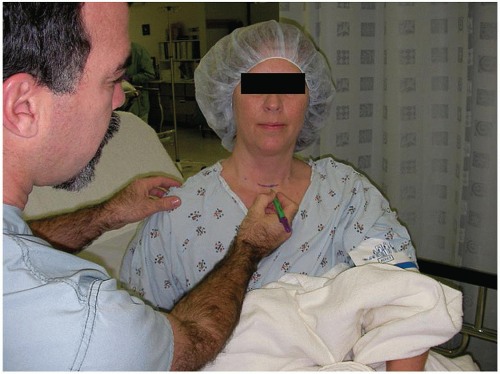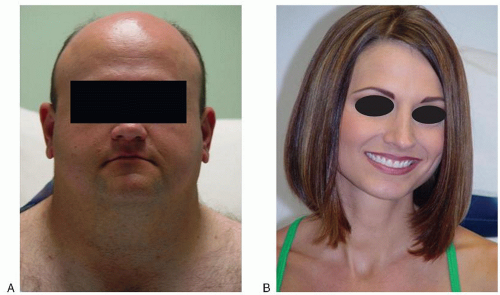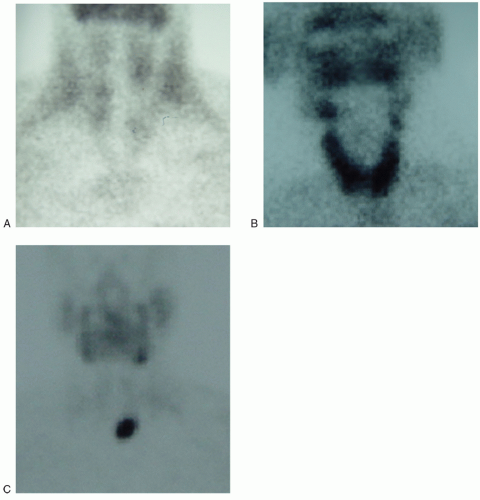Video-Assisted Parathyroidectomy
David J. Terris
INTRODUCTION
The management of the patient with primary hyperparathyroidism (PHPT) has changed dramatically in the last 10 years with the introduction of robust preoperative imaging and the availability of rapid intraoperative parathyroid hormone (PTH) assays. Single-gland surgery (described variously as targeted, directed, focused, or minimally invasive) is now preferred for the vast majority of patients with uncomplicated PHPT. With the high success rates and low morbidity of a modern parathyroidectomy, attention can now be shifted to patient-centered issues such as convenience of surgery and cosmesis. These considerations have spawned outpatient management and video-assisted techniques, among other novel approaches. The application of high-resolution endoscopy has permeated most areas of surgery, and the endocrine field is now no exception. The intense illumination and high-fidelity magnification may help improve visualization of critical structures during surgery and have allowed surgeons to use quite small incisions in order to retrieve parathyroid adenomas. Many patients can now enjoy a sutureless, drainless, outpatient procedure that leaves a scar of ½ to ¾ of an inch.
HISTORY
The proper indications for surgery should be met prior to contemplating a video-assisted or any other type of parathyroidectomy. The history is therefore focused on soliciting the classic symptoms associated with PHPT (“moans, bones, groans, and stones”) as well as the less discrete but sometimes disabling symptoms such as depression, fatigue, memory loss, anorexia, constipation, nausea, poor sleep, and irritability.
PHYSICAL EXAMINATION
It is so unusual to be able to palpate a parathyroid adenoma that when this is possible, one should anticipate the presence of a parathyroid carcinoma. Assessment for lymphadenopathy should be undertaken for the same reason. Preoperative examination of the larynx is encouraged as patients with an unsuspected vocal cord paralysis can maintain a normal voice. Assessment of body habitus is important for the video-assisted technique and may include calculation of a body mass index.
INDICATIONS
All patients with symptomatic PHPT should undergo surgery if possible. National Institutes of Health panels have been convened several times (most recently in 2008) to issue guidelines for surgical intervention in patients with asymptomatic PHPT that are somewhat strict but serve as a starting point in defining surgical eligibility. These indications include creatinine clearance <60 mL/minute, age <50, calcium levels more than
1 mg/dL above normal, and reduced bone mineral density (T score on a dual-energy x-ray absorptiometry scan of <2.5 at any site). Despite these commonly recognized guidelines, there are many who believe that confirmation of the diagnosis of hyperparathyroidism is sufficient to recommend surgery, particularly with the availability of modern techniques. Therefore, most surgeons extend beyond the published indications for surgery on a regular basis after careful consultation with both the patient and the referring endocrinologist.
1 mg/dL above normal, and reduced bone mineral density (T score on a dual-energy x-ray absorptiometry scan of <2.5 at any site). Despite these commonly recognized guidelines, there are many who believe that confirmation of the diagnosis of hyperparathyroidism is sufficient to recommend surgery, particularly with the availability of modern techniques. Therefore, most surgeons extend beyond the published indications for surgery on a regular basis after careful consultation with both the patient and the referring endocrinologist.
Once a decision for surgery has been reached, the eligibility criteria for a video-assisted parathyroidectomy technique include the presence of localizing studies (usually either an ultrasound or a sestamibi scan), nonobese neck (Fig. 22.1), and no suspicion of cancer. While some European authors have reported on fourgland exploration using an endoscopic approach, I prefer an open exploration when all glands will be examined. Obese necks demand sufficient additional depth of dissection for exposure that a minimally invasive nonendoscopic technique is preferred. Patients with cancer should have open surgery.
CONTRAINDICATIONS
A patient who has had prior neck surgery or in whom a cancer is anticipated should not undergo video-assisted surgery. Most patients with nonlocalizing studies or those whose imaging suggests an ectopic location such as the mediastinum or submandibular triangle should undergo conventional surgery (Fig. 22.2). Patients who are infirm or have substantial medical comorbidities are probably best served by conventional techniques (although as a targeted, single-gland exploration).
PREOPERATIVE PLANNING
Planning falls into one of three principal areas: confirmation of the diagnosis, imaging of the affected gland(s), and the acquisition of informed consent. While most patients are referred with a diagnosis of PHPT, confirmation by laboratory assessment of ionized and total calcium, PTH level, vitamin D level, and in some cases a 24-hour urine calcium level may be helpful.
My preferred imaging modalities consist of both surgeon-performed office ultrasound and a high-quality Tc-sestamibi scan with fused CT images. The CT may be particularly helpful for defining the depth of the adenoma and to help to prevent the commonly missed overly descended superior gland that masquerades as an inferior adenoma. If neither of these imaging studies are localizing, a four-gland exploration is anticipated and video-assisted techniques are not utilized.
Patients are made aware of the usual risks and complications of thyroid compartment surgery, and in this case, including a small risk of persistent hyperparathyroidism and a remote risk of transient or permanent hypoparathyroidism.
SURGICAL TECHNIQUE
The patient is marked for the surgical incision while seated upright in the holding area to facilitate identification of the optimal location in the neck (Fig. 22.3), which is typically just above the sternal notch in a natural skin crease. Once in the operating room, the patient is positioned supine on the table, and the arms are tucked in papoose fashion. The patient is intubated with a conventional endotracheal tube as laryngeal nerve monitoring is not needed for these cases. (Alternatively, these operations can easily be accomplished under local anesthesia
in motivated patients who are properly selected.) I prefer to rotate the operating table 180 degrees from the anesthesiologist, and blood samples are drawn from a peripheral vein in the foot.
in motivated patients who are properly selected.) I prefer to rotate the operating table 180 degrees from the anesthesiologist, and blood samples are drawn from a peripheral vein in the foot.
 Get Clinical Tree app for offline access 
|




